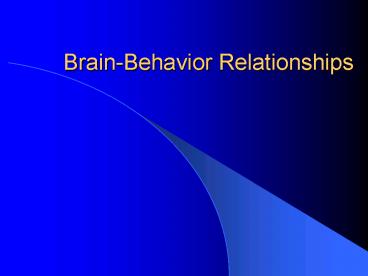BrainBehavior Relationships PowerPoint PPT Presentation
1 / 35
Title: BrainBehavior Relationships
1
Brain-Behavior Relationships
2
Gross Structures of the Brain
- HINDBRAIN
- Medulla
- Reticular Formation
- Pons and Cerebellum
- MIDBRAIN
- FOREBRAIN
- Diencephalon (Thalamus, Hypothalamus)
- Cerebrum (Basal Ganglia, Limbic System, Cerebral
Cortex)
3
Cerebral Hemispheres
- Basal Ganglia
- 3 main functions
- Limbic System
- 4 structures
- Cerebral Cortex
4
Cortical Connections
- Between hemispheres (e.g., corpus callosum)
- Within a hemisphere, between one lobe and another
(association tracks e.g., arcuate fasciculus) - Cortex-Subcortical (e.g., internal capsule)
5
Review of Neuroanatomy (cont.)
- Skull and Meninges
- Vascular System
- Ventricular System and CSF
6
Principles of Cortical Organization
- Cortical Zones
- Cortical Lobes
- Occipital, Frontal, Parietal, Temporal
- Functional Systems
- Lateralization of Function
7
Cortical Zones
- Primary
- Secondary
- Tertiary
8
Cortical Lobes
9
Cortical Lobes
- Occipital Mediate sight visual perception
visual knowledge - Parietal tactile sensations position sense
spatial relations - Left sequential. Logical spatial
- Right holistic spatial information
10
Cortical Lobes (cont.)
- Temporal auditory and olfactory abilities
integrating visual perceptions with other sensory
info new learning emotion motivation - Frontal motor functions, including speech
executive functions integration of emotional and
motivational states
11
Lateralization of Function
- Left Hemisphere
- Speech and Language
- Linear Processing
- Well-routinized codes
- Details
- Contralateral attention
- Positive Emotions
- Right Hemisphere
- Prosody, Humor, Non-literal
- Configural Processing (faces)
- More adept at novel
- Global Percepts
- Global attention
- Negative Emotions
12
Functions
- Attention and arousal (see text)
- Memory (know 4 different regions involved
- Hippocampus surrounding areas
- Basal forebrain (cells that produce
Acetylcholine) - Frontal Cortex
- Basal Ganglia (procedural memory)
- Language
13
Memory
- Amnesia (HM)
- Immediate vs. Long-term
- Remote memory vs. Antereograde memory
- Implicit vs. Explicit Memory
- Frontal Lobes role in retrieval and organization
- Cortical Dementia
- Early Detection
- Progression/Diagnosis
14
Memory Rehabilitation
Attention
Encoding
Storage
Retrieval
15
Language
- Aphaisa
- Expressive Aphasia
- Receptive Aphasia
- Distinguish
- Psychological Issues
16
Prefrontal Cortex
Frontal Cortex
Striatum
Globus Pallidus/ Substantia Nigra
Thalamus
17
5 Frontal-Subcortical Circuits
- Motor
- Occulomotor
- Dorsolateral
- Orbitofrontal-Ventral PFC
- Anterior Cingulate
18
Major Functional Divisions of Frontal Lobe
19
Dorsolateral Syndrome
- Executive function deficits
- Poor organizational strategies
- Poor memory strategies
- Working Memory
- Impaired set-shifting
- Attentional control (distractible)
20
Orbitofrontal-Ventral PFC Syndrome
- Phineas Gage
- Stimulus-Reward Associations
- Decision-Making
- Appropriate Social Behavior
21
Theories of Difference in Frontal Functioning
- (Paik, 1998)
- DLPFC CEO
- VLPFC Moment-to-Moment reactions
22
Moral Decisions
- Green et al. (2001) Science (fMRI)
- Moral Judgment versus Non-Moral judgment
- Findings Medial frontal and posterior cingulate
activity when people ponder moral, personal
dilemmas. - Conclusion Emotional integration component of
decision-making.
23
Anterior Cingulate Syndrome
- Akinetic Mutism
- Apathetic, no spontaneous speak, answer in
monosyllables - Display no emotion
24
Points to Remember
- Behavioral deficits determined by site, size,
laterality, nature of lesion, etc. - Individual variation.
- Difficulty to develop real-world tasks to assess
FL functioning.
25
Diseases that commonly affect Frontal functioning
- Affective Disorders
- Depression
- Traumatic Brain Injury
- Schizophrenia
- Some Dementing Illnesses
26
Traumatic Disorders
- Mechanisms of Injury
- Primary
- Secondary
- Initial Assessment of Severity
- Glascow Coma Scale
- Length of Consciousness
- Length of PTA
27
TBI (cont.)
- Treatment
- Cognitive and Emotional Effects
- Rehabilitation
28
Principles of Nerve Cell Communication
- Neuron Membrane
- Electrostatic pressure
- Diffusion
- Communication within a neuron
- Movement of electrical charge
- Communication between neurons
- Electrical signal to chemical signal
29
Biochemical Activity of the Brain
- Membrane of Neuron
- Synapse
- 2 Types of Receptors
- Ionotropic (fast but short-lived)
- Metabotropic (slow, but prolonged effect)
- Either may be excitatory or inhibitory
30
Neurotransmitters
- Excitatory (glutamate)
- Inhibitory (GABA)
- Neuromodulators (dopamine)
31
Classes of Psychoactive Medications
- Neuroleptics (Haldol)
- Antidepresants (Prozac)
- Tranquilizers (diazepam or Valium)
- Stimulants (amphetamine)
- Time Course and Side Effects
32
Switch Gears-Developmental Issues (Ch 2)
33
Stages of Dying
- Shock and Avoidance
- Anger
- Bargaining
- Depression
- Acceptance
- Advantages and Disadvantages of Model
34
Neurobiology of Aggression
- Parenting
- Abuse Physical and Mental
- PFC damage
- Impulsive vs. Pre-meditated
- Lesion Location
35
Attachment
- Evident 6-8 months
- Fear, Ability to crawl
- Strange Situation (Ainsworth,
- Anxious-ambivalent
- Secure
- Anxious-avoidant
- Quality of Attachment

